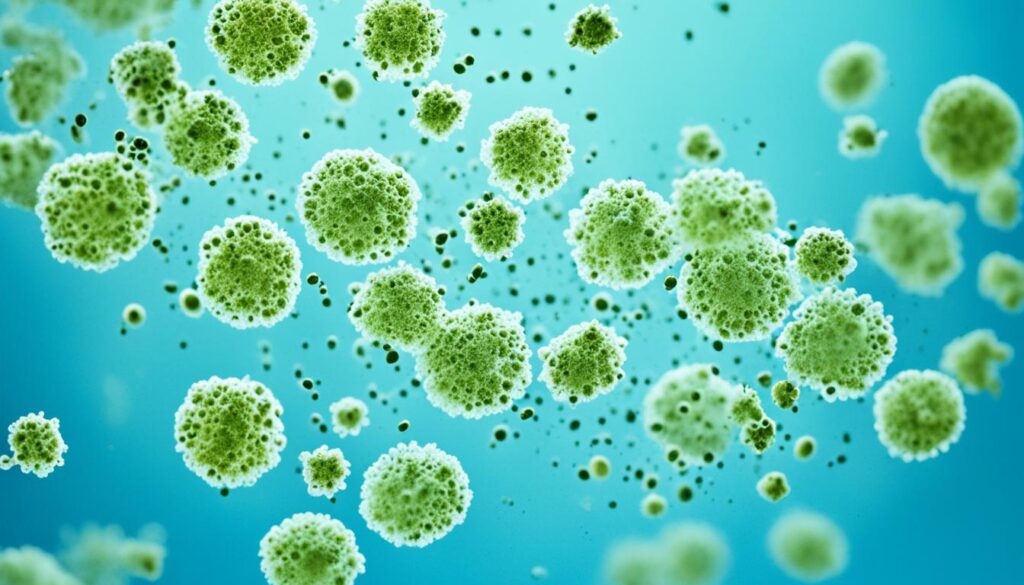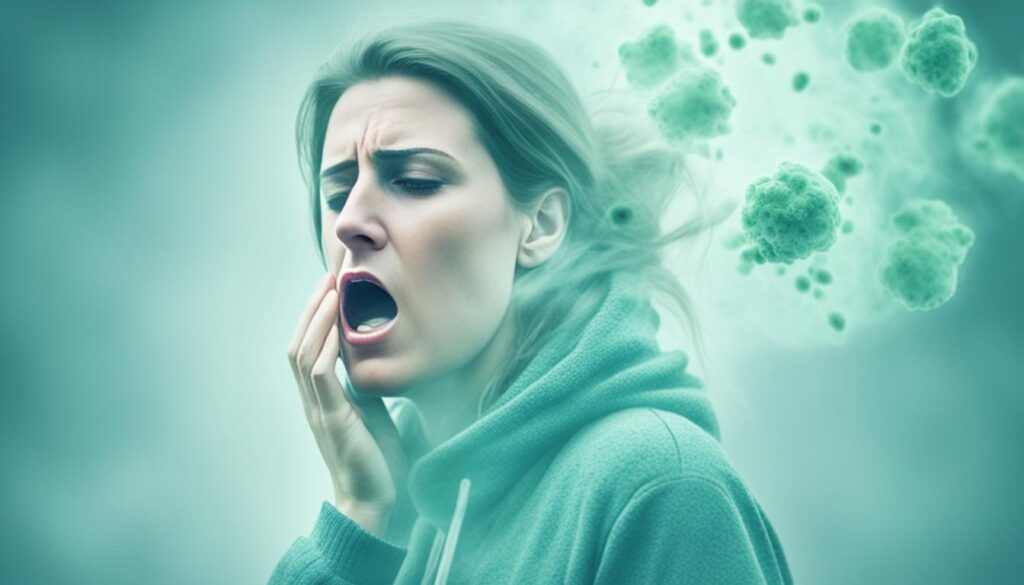
The Complete Guide to Mold skin
Welcome to our comprehensive guide on mold skin exposure. Mold is a common problem in many households and can pose serious risks to our health. In this guide, we will explore everything you need to know about mold skin exposure, including its potential health impacts and safe methods for removing mold.
Key Takeaways:
- Mold skin exposure can lead to various health issues.
- Allergic reactions, respiratory problems, and skin infections are common among individuals exposed to mold.
- Proper protective clothing, ventilation, and professional remediation services are essential for safe mold removal.
- Regular inspection and maintenance can help prevent mold growth and skin exposure.
- Consulting a healthcare professional is recommended if you experience persistent symptoms after mold exposure.
Understanding Mold Skin Exposure
When it comes to mold exposure, most of us think about inhaling mold spores or coming into contact with contaminated surfaces. However, it’s essential to understand that mold can also affect our skin. In this section, we will delve into the details of mold skin exposure, including how mold spores can come into contact with the skin, the potential symptoms that may arise from exposure, and how to identify if mold is affecting your skin.
Mold Spores and Skin Contact
Like other forms of mold exposure, mold spores are the primary culprits when it comes to skin contact. These tiny fungal particles are lightweight and can easily become airborne. They can attach to our skin when we come into direct contact with mold-contaminated surfaces or when the spores are released into the air and land on our skin.
It’s important to note that not all mold spores will cause negative reactions on the skin. However, certain individuals may be more susceptible to skin issues due to mold exposure, especially those with pre-existing skin conditions or compromised immune systems.
Symptoms of Mold Skin Exposure
The symptoms of mold skin exposure can vary from person to person, depending on factors such as the individual’s sensitivity, the type of mold, and the duration of exposure. Common symptoms may include:
- Itching: Skin may become itchy and irritated, especially in areas that have come into direct contact with mold.
- Rash: Red, inflamed patches or a rash may develop on the skin.
- Burning Sensation: Some individuals may experience a burning or tingling sensation on the affected skin.
- Dryness: Mold exposure can cause skin dryness and flakiness.
- Swelling: In rare cases, mold exposure may lead to localized swelling of the skin.
If you suspect that mold exposure is causing skin issues, it’s crucial to consult with a healthcare professional for an accurate diagnosis and appropriate treatment.
Identifying Mold on the Skin
Identifying mold on the skin can be challenging as it can often be mistaken for other skin conditions. However, there are a few signs that can help you determine if mold is affecting your skin:
- Persistence: If your skin issues persist or worsen despite home remedies or over-the-counter treatments, it may indicate mold-related skin problems.
- Pattern: Mold-related skin issues may appear in patterns or clusters, indicating the areas of contact with mold spores.
- Source of Exposure: If you have been in an environment with visible mold growth or have recently experienced water damage in your home, the likelihood of mold-related skin issues increases.
It’s important to note that self-diagnosis may not always be accurate. If you suspect mold is affecting your skin, it’s crucial to consult a healthcare professional for proper evaluation and guidance.
Understanding mold skin exposure is essential for effectively managing the potential health impacts. In the next section, we will explore the various health effects that mold exposure can have on individuals, ranging from allergic reactions to respiratory issues.

Health Impacts of Mold Skin Exposure
Exposure to mold skin can have various detrimental effects on individuals. It can lead to allergic reactions, respiratory issues, and an increased risk of skin infections. Understanding these health impacts is crucial in order to take necessary precautions and seek appropriate treatment.
Allergic Reactions
Mold skin exposure can trigger allergic reactions in some individuals. Common symptoms include:
- Skin rashes – Itchy red patches or bumps on the skin
- Hives – Swollen, pale-colored bumps or welts on the skin
- Watery eyes – Excessive tearing or discomfort in the eyes
- Sneezing and congestion – Runny or stuffy nose accompanied by sneezing
These allergic reactions can vary in severity, with some individuals experiencing mild discomfort while others may have more severe symptoms. It is important to consult a healthcare professional if you suspect you are experiencing mold-related allergic reactions.
Respiratory Issues
Mold skin exposure can also lead to respiratory issues, particularly for individuals with pre-existing respiratory conditions such as asthma or chronic obstructive pulmonary disease (COPD). Common respiratory symptoms associated with mold exposure include:
- Coughing – Persistent or worsened cough
- Wheezing – High-pitched whistling sound when breathing
- Shortness of breath – Difficulty breathing or feeling breathless
- Chest tightness – Discomfort or pressure in the chest area
If you have a respiratory condition and notice these symptoms after mold skin exposure, it is important to seek medical advice promptly. Proper management of respiratory issues related to mold exposure is crucial to prevent complications and improve overall respiratory health.
Skin Infections
Mold skin exposure can increase the risk of developing skin infections. The presence of mold on the skin can disrupt the skin barrier, making it more susceptible to infection-causing bacteria or fungi. Common skin infections that can occur due to mold exposure include:
- Fungal infections – Such as athlete’s foot or ringworm
- Bacterial infections – Including cellulitis or impetigo
- Yeast infections – Such as Candida or yeast dermatitis
If you develop any signs of a skin infection, such as redness, swelling, warmth, pain, or the presence of pus, it is important to consult a healthcare professional for appropriate diagnosis and treatment. Timely intervention can help prevent the spread of infection and promote proper healing.
It is crucial to take steps to minimize mold skin exposure and maintain good skin hygiene in order to prevent or control these health impacts. Proper ventilation, regular cleaning of living spaces, and personal hygiene practices can all contribute to reducing mold-related health risks.
Next, we will discuss safe and effective methods for removing mold from the skin to further ensure the well-being of individuals exposed to mold.

Safe Removal Methods for Mold Skin
When it comes to removing mold from the skin, it is crucial to prioritize safety and effectiveness. In this subsection, we will provide you with essential information on the proper methods for removing mold from your skin. By following these guidelines, you can minimize the risk of further exposure and ensure the safety of yourself and others around you.
Wearing Protective Clothing
Protective clothing is an essential component of safe mold removal. It helps prevent direct contact with mold spores and minimizes the risk of skin irritation or allergic reactions. When removing mold from your skin, make sure to wear gloves, long sleeves, pants, and closed-toe shoes. This will create a barrier between your skin and the mold, providing an extra layer of protection.
Ensuring Proper Ventilation
Proper ventilation is crucial during the mold removal process. Mold spores can become airborne, leading to respiratory issues if inhaled. When removing mold from your skin, make sure to work in a well-ventilated area. Open windows and use fans to increase airflow and reduce the concentration of mold spores in the air.
Professional Remediation Services
In some cases, it may be necessary to seek professional remediation services for mold removal from the skin. This is especially true if the mold is extensive, difficult to reach, or if you have a pre-existing respiratory condition. Professional remediation experts have the knowledge, experience, and proper equipment to safely remove mold from your skin and ensure thorough treatment.
Remember, mold can be harmful, and improper removal methods can lead to further health risks. It is always wise to consult with a healthcare professional or a mold remediation specialist if you have concerns about mold skin exposure.
By following these safe removal methods for mold skin, you can effectively protect yourself and reduce the potential health risks associated with mold exposure. Always prioritize your well-being and take the necessary precautions to ensure a safe and thorough removal process.
Conclusion
In conclusion, mold skin exposure poses a significant risk to our health. It is crucial to understand the potential dangers and take proactive measures to protect ourselves and our loved ones from the negative impacts of mold.
By following the guidelines outlined in this comprehensive guide, you can effectively minimize the risks associated with mold skin exposure. Remember to wear protective clothing and gear when dealing with mold, ensuring that your skin is shielded from direct contact.
In addition, it is essential to maintain proper ventilation during the mold removal process. Good airflow helps reduce the concentration of mold spores in the environment and prevents further exposure.
While it may be possible to handle small-scale mold issues independently, large and persistent mold infestations may require professional remediation. Seeking assistance from experienced professionals ensures the safe and thorough removal of mold from your home or workplace.




